Outline
1.
Nature of word stress
2.
Place of word stress in English. Degrees of stress
3.
Functions and tendencies of the English stress
4.
Typology of accentual structures
1. Nature of word stress
The
sequence of syllables in the word is not pronounced identically. The
syllable or syllables which are uttered with more prominence than the
other syllables of the word are said to be stressed or accented.
Stress in the isolated word is termed word stress; stress in
connected speech is termed sentence stress.
Stress
is defined differently by different authors. B.A. Bogoroditsky, for
instance, defined stress as an increase of energy, accompanied by an
increase of expiratory and articulatory activity. D. Jones defined
stress as the degree of force, which is accompanied by a strong force
of exhalation and gives an impression of loudness. H. Sweet also
stated that stress, is connected with the force of breath. According
to A.C. Gimson, the effect of prominence is achieved by any or all of
four factors: force, tone, length and vowel colour.
If
we compare stressed and unstressed syllables in the words contract
[‘kσntr?kt],
to contract [kən’tr?kt], we may note that in the stressed syllable:
(a)
the force is greater, which is connected with more energetic
articulation;
(b)
the pitch of voice is higher, which is connected with stronger
tenseness of the vocal cords and the walls of the resonance chamber;
(c)
the quantity of the vowel [?] in [kən’tr?kt] is greater, the vowel
becomes longer;
(d)
the quality of the vowel [?] in the stressed syllable is different
from the quality of this vowel in the unstressed position, in which
it is more narrow than [‘ж].
On
the auditory level a stressed syllable is the part of the word which
has a special prominence. It is produced by a greater loudness and
length, modifications in the pitch and quality. The physical
correlates are: intensity, duration, frequency and the formant
structure. All these features can be analyzed on the acoustic level.
Word stress can be defined as the singling out of one or more
syllables in a word, which is accompanied by the change of the force
of utterance, pitch of the voice, qualitative and quantitative
characteristics of the sound, which is usually a vowel. In different
languages one of the factors constituting word stress is usually more
significant than the others. According to the most important feature
different types, of word stress are distinguished in different
languages.
1)
If special prominence in a stressed syllable or syllables is achieved
mainly through the intensity of articulation, such type of stress is
called dynamic, or force stress.
2)
If special prominence in a stressed syllable is achieved mainly
through the change of pitch, or musical tone, such accent is called
musical, or tonic. It is characteristic of the Japanese, Korean and
other oriental languages.
3)
If special prominence in a stressed syllable is achieved through the
changes in the quantity of the vowels, which are longer in the
stressed syllables than in the unstressed ones, such type of stress
is called quantitative.
4)
Qualitative type of stress is achieved through the changes in the
quality of the vowel under stress.
English
word stress is traditionally defined as dynamic, but in fact, the
special prominence of the stressed syllables is manifested in the
English language not only through the increase of intensity, but also
through the changes in the vowel quantity, consonant and vowel
quality and pitch of the voice.
Russian
word stress is not only dynamic but mostly quantitative and
qualitative. The length of Russian vowels always depends on the
position in a word.
Now
we should like to distinguish the notions of word stress and sentence
stress. They are first of all different in their sphere of
application as they are applied to different language units: word
stress is naturally applied to a word, as a linguistic unit, sentence
stress is applied to a phrase. Secondly, the distinction of the
rhythmic structure of a word and a phrase is clearly observed in the
cases when the word stress in notional words is omitted in a phrase,
e.g. I ‘don’t think he is ‘right or when the rhythmic structure of
the isolated word does not coincide with that of a phrase, e.g.
‘Fifteen. ‘Room Fifteen. ‘Fifteen ‘pages.
So
in a speech chain the phonetic structure of a word obtains additional
characteristics connected with rhythm, melody, and tempo. Though the
sentence stress falls on the syllable marked by the word stress it is
not realized in the stressed syllable of an isolated word but in a
word within speech continuum. Since the spheres of word stress and
sentence stress fall apart their functions are actually different.
Sentence stress organizes a sentence into a linguistic unit, helps to
form its rhythmic and intonation pattern, and performs its
distinctive function on the level of a phrase.
Stress
difficulties peculiar to the accentual structure of the English
language are connected with the vowel special and inherent
prominence. In identical positions the intensity of English vowels is
different. The highest in intensity is /a:/, then go /о:,
з:,
i:, u:, ?, σ,
e, υ,
i/.
All
English vowels may occur in accented syllables, the only exception is
/ə/, which is never stressed. English vowels /i, и,
ə υ/
tend to occur in unstressed syllables. Syllables with the syllabic
/1, m, n/ are never stressed. Unstressed diphthongs may partially
lose their glide quality. In stressed syllables English stops have
complete closure, fricatives have full friction, and features of
fortis/lenis distinction are clearly defined.
Соседние файлы в предмете [НЕСОРТИРОВАННОЕ]
- #
- #
- #
- #
- #
- #
- #
- #
- #
- #
- #
Скачать материал

Скачать материал


- Сейчас обучается 396 человек из 63 регионов


- Сейчас обучается 268 человек из 64 регионов




Описание презентации по отдельным слайдам:
-
1 слайд
Lecture 5. Word Stress
The Nature of Word Stress.
The Place of Word Stress in English. The Degrees of Stress.
The Functions and Tendencies of the English Stress.
The Typology of Accentual Structures. -
2 слайд
The syllable or syllables which are uttered with more prominence than the other syllables of the word are said to be stressed or accented.
Stress in the isolated word is termed word stress; stress in connected speech is termed sentence stress.
-
3 слайд
Word stress can be defined as the singling out of one or more syllables in a word, which is accompanied by the change of the force of utterance, pitch of the voice, qualitative and quantitative characteristics of the sound, which is usually a vowel.
In different languages one of the factors constituting word stress is usually more significant than the others. -
4 слайд
If special prominence in a stressed syllable or syllables is achieved mainly through the intensity of articulation, such type of stress is called dynamic, or force stress.
-
5 слайд
If special prominence in a stressed syllable is achieved mainly through the change of pitch, or musical tone, such accent is called musical, or tonic. It is characteristic of the Japanese, Korean and other oriental languages.
-
6 слайд
If special prominence in a stressed syllable is achieved through the changes in the quantity of the vowels, which are longer in the stressed syllables than in the unstressed ones, such type of stress is called quantitative.
Qualitative type of stress is achieved through the changes in the quality of the vowel under stress.
-
7 слайд
The traditional classification of languages concerning place of stress in a word is into those with a fixed stress and those with a free stress.
In languages with a fixed stress the occurrence of the word stress is limited to a particular syllable in a polysyllabic word.
In languages with a free stress its place is not confined to a specific position in the word.
E.g. ‘appetite — be’ginning — ba’lloon -
8 слайд
The word stress in English is not only free but it may also be shifting, performing the semantic function of differentiating lexical units, parts of speech, grammatical forms.
E.g. ‘contrast — con’trast; ‘music — mu’sician. -
9 слайд
There are actually as many degrees of stress in a word as there are syllables.
examination
ɪɡ.ˌzæm.ɪ.ˈneɪʃ. Ən
3 2 4 1 5Degrees of Word Stress
-
10 слайд
The primary stress is the strongest, it is marked by number 1, the secondary stress is the second strongest marked by 2. All the other degrees are termed weak stress. Unstressed syllables are supposed to have weak stress.
-
11 слайд
American linguists distinguish four degrees of word stress and term them: primary stress, secondary stress, tertiary stress and weak stress. The difference between the secondary and tertiary stresses is very subtle and seems subjective.
-
12 слайд
The second pretonic syllables of such words as libe’ration, recog’nition are marked by secondary stress in BrE, in AmE they are said to have tertiary stress.
In AmE tertiary stress also affects the suffixes -ory, -ary, -ony of nouns and the suffixes –ate, -ize, -y of verbs, which are considered unstressed in BrE, e.g. ‘territory, ‘ceremony, ‘dictionary; ‘demonstrate, ‘organize, ‘simplify.
-
13 слайд
Word stress in a language performs three functions.
Functions of Word Stress -
14 слайд
Word stress constitutes a word, it organizes the syllables of a word into a language unit having a definite accentual structure, that is a pattern of relationship among the syllables; a word does not exist without the word stress.
Constitutive function -
15 слайд
Word stress enables a person to identify a succession of syllables as a definite accentual pattern of a word.
Identificatory / recognitive function -
16 слайд
Word stress alone is capable of differentiating the meaning of words or their forms.
The accentual patterns of words or the degrees of word stress and their positions form oppositions:
E.g. ‘import — im’port, ‘billow — be’low.
Distinctive / contrastive function -
17 слайд
According to Prof. V.O. Vasyliev (V.A.Vassilyev), the distinctive function makes word accent a suprasegmental phonological unit which performs a sense-differentiating function. He calls it accenteme.
-
18 слайд
According to Prof. V.O. Vasyliev (V.A. Vassilyev), they are:
The recessive tendency
The rhythmic tendency
The retentive tendency
The semantic factor
Word Stress Tendencies
-
19 слайд
In Germanic languages the word stress originally fell on the initial syllable or the second syllable, the root syllable in the English words with prefixes.
Unrestricted recessive tendency is observed in the native English words having no prefix, e.g. mother, daughter, brother, swallow, in assimilated French borrowings, e.g. reason, colour, restaurant.
Restricted recessive tendency marks English words with prefixes which have no referential meaning now, e.g. foresee, begin, withdraw, apart.The recessive tendency
-
20 слайд
The rhythm of alternating stressed and unstressed syllables gave birth to this tendency in the present-day English which caused the appearance of the secondary stress in the multisyllabic French borrowings, e.g. ˌrevo’lution, ˌorgani’sation, aˌssimi’lation, etc.
It also explains the placement of primary stress on the third syllable from the end in three- and four-syllable words, e.g. ‘cinema, ‘situate, ar’ticulate.The rhythmic tendency
-
21 слайд
A third tendency was traced in the instability of the accentual structure of English word stress: a derivative often retains the stress of the original or parent word,
E.g. ‘person — ‘personal — ˌperso’nality,
‘similar — as’similate,
recom’mend — recommen ‘dation.The retentive tendency
-
22 слайд
It determines the stress in compound words and words with so-called separable prefixes.
The majority of such words have two equally strong stresses, both stressed parts are considered to be of equal semantic importance, with semantic factor thus canceling the rhythmic tendency in word stressing, e.g.
Compound adjectives: hard-working, blue-eyed;
Verbs with postpositions: sit down, take off;
Numerals from 13 to 19: fourteen, sixteen.The semantic factor
-
23 слайд
G.P. Torsuyev classifies the accentual types according to the number of stressed syllables, their degree or character (the main and the secondary stress).
The most widely spread accentual types are:
1. [‘___]. This accentual type marks both simple and compound words. The accentual structures of this type may include two and more syllables, e.g. ‘father, ‘possibly, ‘mother-in-law, ‘gas-pipe.The Typology of Accentual Structure
-
24 слайд
2. [ ‘_ ‘_ ]. The accentual type is commonly realized in compound words, most of them are with separable prefixes, e.g. ‘radio-‘active, ‘re’write, ‘diso’bey.
3. [‘_ ˌ___]. The type is realized both in simple and compound words, very common among compound words, e.g. ‘hair-,dresser, ‘substructure.
-
25 слайд
4. [ˌ _’___]. The accentual type marks a great number of simple words and some compound words as well. In simple words the stresses fall onto:
the prefix and the root: ˌmaga’zine;
the root and the suffix: ˌhospi’tality;
the prefix and the suffix. -
26 слайд
The variability of the word accentual structure is multiplied in connected speech. The accentual structure of words may be altered under the influence of rhythm, e.g. An ‘unpolished ‘stone but: The ‘stone was un’polished.
The tempo of speech may influence the accentual pattern of words. With the quickening of the speed the carefulness of articulation is diminished, the vowels are reduced or elided, the secondary stress may be dropped, e.g. The ‘whole organi’zation of the ‘meeting was ‘faulty.
Найдите материал к любому уроку, указав свой предмет (категорию), класс, учебник и тему:
6 209 883 материала в базе
- Выберите категорию:
- Выберите учебник и тему
- Выберите класс:
-
Тип материала:
-
Все материалы
-
Статьи
-
Научные работы
-
Видеоуроки
-
Презентации
-
Конспекты
-
Тесты
-
Рабочие программы
-
Другие методич. материалы
-
Найти материалы
Другие материалы
- 16.12.2020
- 140
- 0
- 25.11.2020
- 114
- 0
- 14.11.2020
- 119
- 0
- 09.11.2020
- 132
- 0
- 01.11.2020
- 116
- 0
- 21.10.2020
- 124
- 0
- 10.10.2020
- 91
- 0
- 17.09.2020
- 89
- 0
Вам будут интересны эти курсы:
-
Курс повышения квалификации «Правовое обеспечение деятельности коммерческой организации и индивидуальных предпринимателей»
-
Курс повышения квалификации «Формирование компетенций межкультурной коммуникации в условиях реализации ФГОС»
-
Курс повышения квалификации «Организация практики студентов в соответствии с требованиями ФГОС технических направлений подготовки»
-
Курс повышения квалификации «Разработка бизнес-плана и анализ инвестиционных проектов»
-
Курс повышения квалификации «Финансы: управление структурой капитала»
-
Курс повышения квалификации «Финансы предприятия: актуальные аспекты в оценке стоимости бизнеса»
-
Курс повышения квалификации «Методы и инструменты современного моделирования»
-
Курс профессиональной переподготовки «Уголовно-правовые дисциплины: теория и методика преподавания в образовательной организации»
-
Курс повышения квалификации «Финансовые инструменты»
-
Курс профессиональной переподготовки «Гостиничный менеджмент: организация управления текущей деятельностью»
-
Курс профессиональной переподготовки «Осуществление и координация продаж»
-
Курс профессиональной переподготовки «Управление качеством»
Word Stress in English
CONTENTS
1. The nature of Word Stress in
English
.1 Origins of the Word Stress
and the notion of Accent
.2 Types of English Word
Stress2. Place of Word Stress in English
.1 Functions of Word Stress
.2 English accentuation
tendencies
word stress accent vowel
INTRODUCTION
«major part of second language
learners seem to reach adequate proficiency in the spheres of morphology and
syntax, still they have difficulty reaching the same proficiency level in the
fields of phonology and phonetics. Native speakers who are competent users of
the language absolutely know in what way to say a word, know how to pronounce
it. The difficulty attaining the same level as native speakers is found within
the results of interference of the mother tongue with English. The interference
of native Russian as the mother tongue is obscure in learners of English, but
not just in grammar aspect, also in pronunciation and it can be shown in the
comparative display of the word stress that this paper is partly about.this
course paper our attention will be focused on the accentual patterns of English
words. The sequence of syllables in the word is pronounced not even close or
identically. One syllable or syllables that are uttered with some prominence
than the other syllables in the very word, are meant to be stressed or in other
words accented. The correlation of prominences of different syllables in a word
is totally understood as the accentual (stress) structure of the word or its
(accentual) stress pattern.English and Russian linguists worked over the
question of word stress in English as the unique phenomenon. According to D.
Crystal the terms «… heaviness, sound pressure, force, power, strength,
intensity, amplitude, prominence, emphasis, accent, stress» tend to be used
synonymously by most writers. According to G.P. Torsuev the notions
«stressed» and «prominent» should not be used as the
synonyms. The effect of prominence, states the linguist, is made by some
phonetic features of sounds, which have nothing to do with the actual word or
sentence stress.
The actuality
of the investigation may be argued by the fact that nowadays the great
attention is paid to the research of accentual structure of English words.
Because stress or accent fulfill enormous functions of formation words and
compound words. The main aim of the course paper is to clarify types of
stress, places and degrees of word stress, factors and functions of word
stress.
The practical value
of this course paper is that the practical results and conclusions can be used
at the seminars on theoretical and practical phonetics and
lexicology.conclusion all important deductions both of theoretical and of
practical character conformably to the studying sphere of phonetics have been
summed up and formulated.contains of English, Russian and American phoneticians
and linguists, and information from the Internet» devoted to the theory of
phonology, phonetics and intonation as such.
CHAPTER 1. The nature of Word stress
in English
1.1 Origins of the
Word Stress and the notion of Accent
spoken language has a unique
division into segments like vowels and consonants. As we utter them, we make
use of wide range of tones of voice. The speech features that are higher than
the sound segments are length, stress, pitch, intonation, rhythm and juncture.
Here we are describing the nature of word stress.sequence of syllables in the
word is not pronounced identically. The syllable or syllables which are uttered
with more prominence than the other syllables of the word are said to be
stressed or accented. Stress in the isolated word is termed word stress; stress
in connected speech is termed sentence stress.first we have to find out the
meaning of the notions: word stress, intonation, accent. «Different
authors define stress differently. B.A. Bogoroditsky, for instance, defined stress
as an increase of energy, accompanied by an increase of expiratory and
articulatory activity. D. Jones defined word stress as the degree
of force, which is accompanied by a strong force of exhalation and gives an
impression of loudness. H. Sweet also stated that stress, is connected
with the force of breath. According to A.C. Gimson, any or all of four factors
achieve the effect of prominence: force, tone, length and vowel color.native
English listeners, the most important syllable in a word is the stressed
syllable, the primary cue for identifying the word. This makes stress the most
important pronunciation topic. In addition, the characteristics of stressed and
unstressed syllables in single words are mirrored in rhythm. Word stress
is described as a communicatively important pronunciation topic, bridging the
continuum between segmentals (consonants and vowels) and suprasegmentals
(rhythm and intonation)» [20; 17].A.M. suggested another description. He
states that «the word stress can be defined as the singling out of
one or more syllables in а word, which is accompanied by the change of the
force of utterance, pitch of the voice, qualitative and quantitative
characteristics of the vowel sound» [4].the most full and correct
definition can be found in the Dictionary of Linguistics and Phonetics. «A
term used in phonetics to refer to the degree of force used in producing a
syllable. The usual distinction is between stressed and unstressed syllables,
the former being more prominent than the latter (and marked in transcription
with a raised vertical line, [c]. The prominence is usually due to an increase
in loudness of the stressed syllable, but increases in length and often pitch
may contribute to the overall impression of prominence. In popular usage,
‘stress’ is usually equated with an undifferentiated notion of ‘emphasis’ or
‘strength’» [13; 454].notion of stress is supposed to close enough to the
meaning of intonation. Still there exists a huge difference. The difference
between stress and intonation is that » …stress is the relative loudness
of parts of speech where intonation is the variation in the pitch of different
parts of speech. Linguists generally believe that there are about 3 to 4 levels
of stress in the English language. In most cases, stress does not really change
the meaning of words and is more or less associated with the dialect or accent
being used» [8; 138]. There are some cases where this assumption is not
valid — see the table 1.1.

English, where the stress changes the meaning of the word
Loudness has an inherent pitch
component, stress, as the relative loudness, sometimes has an added pitch
variation. This extra pitch variation is called a pitch accent. An
example of a language, which contains a pronounced level of pitch accent is
Turkish. Pitch variations are used to change the stress level of a word mostly
due to rhythmic constraints imposed by the language.long as we are discussing
the notion of accent, it is reasonable to define its meaning. Accent was
originally a loan translation from Greek into Latin (a loan translation is when
each constituent of a compound in one language is translated into its
equivalent in another, and then reassembled into a new compound). » … Greek
prosōidíā (whence English
prosody) was formed from pros ‘to’ and
ōidé ‘song’ (whence English ode);
these elements were translated into Latin ad ‘to’ and cantus ‘song’ (whence
English chant, cant, cantata, canticle), giving accentus. The notion
underlying this combination of ‘to’ and ‘song’ was of a song added to speech —
that is, the intonation of spoken language. The sense of a particular mode of
pronunciation did not arise in English until the 16th century» [6; 4].the
Britannica Encyclopedia exists the following meaning of the accent notion.
» … in phonetics, that property of a syllable which makes it stand out in
an utterance relative to its neighboring syllables. The emphasis on the
accented syllable, relative to the unaccented syllables may be realized through
greater length, higher or lower pitch, a changing pitch contour, greater
loudness or a combination of these characteristics» [10;54].
«The emphasis which makes a
particular word or syllable stand out in a stream of speech — one talks
especially of an accented sound/word/syllable, or the accent(ual) pattern of a
phrase/sentence. The term is usually found in a discussion of metre (metrics),
where it refers to the ‘beats’ in a line of poetry — the accented syllables, as
opposed to the unaccented ones. But any style of spoken language could be
described with reference to the relative weight (accentuation) of its
syllables: one might talk of the ‘strongly accented’ speech of a politician,
for instance., accent is not solely a matter of loudness, but also of pitch and
duration, especially pitch: comparing the verb record (as in I’m
going to record the tune) and the noun (I’ve got a record),
the contrast in word accent between re`cord and `record is made by the
syllables differing in loudness, length and pitch movement. The notion of pitch
accent as also been used in the phonological analysis of these languages,
referring to cases where there is a restricted distribution of tone within
words (as in Japanese). A similar use of these variables is found in the notion
of sentence accent (also called ‘contrastive accent’). This is an
important aspect of linguistic analysis, especially of intonation, because it
can affect the acceptability, the meaning, or the presuppositions of a
sentence, e.g. He was wearing a red hat could be heard as a response to
Was he wearing a red coat?; whereas He was wearing a red hat would
respond to Was he wearing a green hat? The term stress, however,
is often used for contrasts of this kind (as in the phrases ‘word stress’
and ‘contrastive stress’). An analysis in terms of pitch accent is also
possible.total system of accents in a language is sometimes called the
accentual system, and would be part of the study of phonology. The coinage
accentology for the study of accents is sometimes found in European
linguistics. (3) In graphology, an accent is a mark placed above a letter,
showing how that letter is to be pronounced. French accents, for example,
include a distinction between é,
è and ê.
Accents are a type of diacritic» [13; 4].linguists believe that syllabic
and lexical accents do not change the meaning of words in English. However, we
know that syllabic and lexical accents are also components of linguistic
stress along with other concepts such as syllabic and lexical sonority
variations and metrical variations. In those regards, since syllabic stress
does change the meaning of words in English, then so do accent.
1.2 Types of
English Word Stress
has various domains: the word, the
phrase, the sentence. Word accent (also called word stress or lexical stress)
is a part of the characteristic way in which a language is pronounced. Given to
a particular language system, word accent may be:
. Fixed (like in Welsh);
. Predictable (e.g. in
French, where it occurs regularly at the end of words, or in Czech, where it
occurs initially);
. Movable, as in English,
which then leaves accent free to function to distinguish one word from another
that is identical segmentally (e.g. the noun permit versus the verb to
permit).types of word stress are distinguished not only according to its
physical (acoustic) nature and degree, but also according to its position in
different words of the language. «From this point of view two types of
word stress are distinguished: fixed and free.) In languages with fixed
word stress the position of stress is the same in all the words. For
instance, in Czech and Lettish the main stress falls on the first syllable of
each word and grammatical form of а word; in French, stress is tied to the last
syllable of each word; in Polish, it falls on the prefinal syllable of all
words and their grammatical forms.) In languages with free word
stress the primary stress may fall in different words on any syllable. For
example in Russian: к`омната,
раб`ота,
матем`атика,
преподав`атель,
машиностро`ение,
окн`о; in English: `mother, ig`nore, соn`sideÐration,
ciga`rette.
Within frее word stress two subtypes
are distinguished on morphological grounds: constant and shifting.
a. А constant stress
is one which remains on the same morpheme in different grammatical forms of а
word or in different derivatives from one and the same root. For example:
«wonder — `wondering — `wonderful — `wonderfully.
b. А shifting stress
is one which falls on different morphemes in different grammatical forms of а
word or in different derivatives from one and the same root,is also shifted
under the influence of rhythm. For instance, Ber`lin — `Berlin `streets,
Chi`nese — a `Chinese `lantern; un`known — an `unknown writer — The `writer is
`quite un`known., accent can be used at the phrasal level to distinguish
sequences identical at the segmental level (e.g. ‘light housekeeping’ versus
‘lighthouse keeping’ or ‘blackboard’ versus ‘black board’). Finally, accent can
be used at the sentence level to draw attention to one part of the sentence
rather then another (e.g. ‘What did you sign?’ ‘I signed a contract
to do some light housekeeping.’ versus ‘Who signed a contract?’ ‘I
signed a contract to do some light housekeeping.’)» [10; 54].the auditory
level a stressed syllable is the part of the word which has a special
prominence. It is produced by a greater loudness and length, modifications in
the pitch and quality. The physical correlates are: inten sity, duration,
frequency and the formant structure. All these features can be analyzed on the
acoustic level. «Word stress can be defined as the singling out of one or
more syllables in a word, which is accompanied by the change of the force of
utterance, pitch of the voice, qualitative and quantitative characteristics of
the sound, which is usually a vowel. In different languages one of the factors
constituting word stress is usually more significant than the others. According
to the most important feature different types, of word stress are distinguished
in different languages.
) If special prominence in a
stressed syllable or syllables is achieved mainly through the intensity of
articulation, such type of stress is called dynamic, or force stress.
) If special prominence in a
stressed syllable is achieved mainly through the change of pitch, or musical
tone, such accent is called musical, or tonic. It is characteristic of the
Japanese, Korean and other oriental languages.
) If special prominence in a
stressed syllable is achieved through the changes in the quantity of the
vowels, which are longer in the stressed syllables than in the unstressed ones,
such type of stress is called quantitative.
) Qualitative type of stress is
achieved through the changes in the quality of the vowel under stress» [4;
51].word stress is traditionally defined as dynamic, but in fact, the special
prominence of the stressed syllables is manifested in the English language not
only through the increase of intensity, but also through the changes in the
vowel quantity, consonant and vowel quality and pitch of the voice.the
viewpoint of phonology, the main function of stress is to provide a
means of distinguishing degrees of emphasis
or contrast in sentences (sentence stress),
as in The big man looks angry; the term contrastive stress is often used
for this function. Many pairs of words and word
sequences can also be distinguished using stress variation (lexical stress or
word stress), as in the contrast between
An increase in pay is needed and I’m going to increase his pay or
the distinction between `black `bird and `black-bird.analytical question here,
which attracted a great deal of attention in the middle decades of the
twentieth century, is how many degrees of stress need to be recognized in order
to account for all such contrasts, and to show the interrelationships between
words derived from a common root, such as `telegraph, tele`graphic and
te`legraphy.а purely phonetic point of view polysyllabic word has as many
degrees of prominence as there are syllables in it. А. С. Gimson gives the
following distribution of the degrees of stress in the word
«ехаmination»:most prominent syllable is marked by figure 1, the
second degree of prominence — by figure 2, then goes 3, and so on. However, not
all these degrees of prominence are linguistically relevant.majority of British
phoneticians distinguish three degrees of word stress in English:
. primary (the strongest
stress),
. secondary (the second
strongest) and
. weak stress (аll the other
degrees of stress).syllables bearing either primary or secondary stress are
termed stressed, while syllables with weak stress are саlled, somewhat
inaccurately, unstressed.the American structuralist tradition, four such
degrees are usually distinguished, and analyzed as stress phonemes,
namely (from strongest to weakest):
(1) ‘primary’,
(2) ‘secondary’,
(3) ‘tertiary’ and
(4) ‘weak’.contrasts are, however,
demonstrable only on words in isolation, as in the compound elevator operator —
one of several such phrases originally cited to justify analyses of this kind.views
recognized different kinds and degrees of stress, the simplest
postulating a straight stressed v. unstressed contrast, referring to other
factors (such as intonation and vowel quality) to explain such sequences as
elevator operator. «In distinctive feature theories of phonology, the
various degrees of stress are assigned to the syllables of words by means of
the repeated application of rules (such as ‘lexical’, ‘compound’ and ‘nuclear’ stress
rules). Some analysts maintain there is a distinction to be made between
linguistic contrasts involving loudness (which they refer to as ‘stress’) and
those additionally involving pitch (which they refer to as «accent»).
All the examples given above, they would argue, are matters of accent, not stress,
because contrasts in pitch variation are normally involved. Similar problems
arise in the analysis of tone languages.the context of rhythm studies, the
notion of a stress-timed language is often cited, i.e. one where the stresses
fall at roughly regular intervals within an utterance. In analyzing such a
language in this way, the notion of silent stress is sometimes invoked. The
reason is to handle cases where the omission of a stressed syllable in
colloquial speech can none the less be ‘felt’; a regularly cited case in the
abbreviated version of thank you, which is said to be the unstressed
residue of an unspoken stressed + unstressed combination. A sequence of
syllables constituting a rhythmical unit, containing one primary stress, is
known as a stress group. In metrical phonology a stress-foot is a
string containing as its first element a
stressed syllable, followed by zero or more unstressed syllables symbolized by
Σ. The most prominent element in the stress foot is called the head. It
should be noted that ‘foot’, in this context, refers to an underlying
unit, whose phonetic interpretation varies according to the theoretical
approach., in this approach, is a rule, which eliminates stresses produced by
foot construction. When two stressed syllables are immediately adjacent, the
situation is described as stress clash. Speakers have a tendency to avoid
stress clash; for example, the word thirteen is normally stressed on the
second syllable, but in the phrase thirteen men, the stress shifts to
the first syllable» [13; 456].languages, stressed and unstressed syllables
differences can be distinguished by differences in length, pitch, loudness, or
vowel quality. As the chart below shows, English makes use of all these
distinctions. See table 1.2.

Characteristics of levels of stress in words
, wedistinguished the fact: if а
word contains more than one syllable, the relative prominence of those
syllables differs. There may be one prominent syllable in а word as compared
with the rest of the syllables of the same word (im`portant), or two equally
prominent syllables (`misbe`have), or two unequally prominent syllables
(е`xami`nation), or more than two prominent syllables (`unre`lia`bility). Such
syllables are said to be stressed, but in every unique way.
CHAPTER 2. Place of word Stress in
English
.1 Functions of Word Stress
any phonological unit, word stress
performs three functions: constitutive, distinctive and identificatory.
. «Word stress has а
constitutive function as it arranges syllables into а word by forming its
stress pattern. Without а definite stress pattern а word stops being а word and
becomes just а sequence of syllables.
. Word stress has а
distinctive function because it helps to differentiate the meaning of words of
the same morphological structure. The opposition of the primary stress and weak
stress can differentiate the parts of speech, like:n — subject vn — object vn —
import vn — insult vn — export vn — progress vn — combine vn — conduct vn —
frequent vn — present voppositions may differentiate the actual meaning of the
some words:
`billow (naval term) — be`low
(down);
`artist — ar`tist.opposition of the
second primary stress to weak stress is also distinctive:
`re`cover (put a new cover on) —
re`cover (get well again);
`restrain (strain again) — re`strain
(keep in check).primary stress opposed to the secondary stress
can sometimes differentiate the meaning as well:
`recre`ation (creating anew) —
recre`ation (amusement).
А compound noun is differentiated
from а free word combination by the opposition of tertiary stress to primary
stress:
`black-board — `black `board;
`stong-box — `strong `box;
`goldfish — `gold `fish;
`blackbird — `black `bird., however,
the second component of such compound nouns is considered to have weak stress,
the distinctive function in such minimal pairs will be realized through the
opposition of weak stress (in the `compound) and рrimary stress.
. Word stress has an
identificatory function because the stress patterns of words enable people to
identify definite combinations of sounds as meaningful linguistic units. А
distortion of the stress patterns may hamper understanding or produce а strange
accent» [4; 57].the terms of our research work it is necessary to mention
that «the accentual structure of English words is liable to instability
due to the different origin of several layers in the Modern English word-stock.
In Germanic languages the word stress originally fell on the initial syllable
or the second syllable, the root syllable in the English words with prefixes.
This tendency was called recessive. Most English words of Anglo-Saxon
origin as well as the French borrowings (dated back to the 15th century) are
subjected to this recessive tendency. Unrestricted recessive tendency is
observed in the native English words having no prefix, e.g. mother,
daughter, brother, swallow, etc., in assimilated French borrowings, e.g. reason,
colour, restaurant. Restricted recessive tendency marks English words with
prefixes, e.g. foresee, begin, withdraw, apart. A great number of words
of Anglo-Saxon origin are monosyllabic or disyllabic, both notional words and
form words. They tend to alternate in the flow of speech, e.g. ‘don’t
be’lieve he’s ‘right.rhythm of alternating stressed and unstressed
syllables gave birth to the rhythmical tendency in the present-day English
which caused the appearance of the secondary stress in the multisyllabic French
borrowings, e.g. revolution, organi’sation, assimilation, etc. It also
explains the placement of primary stress on the third syllable from the end in
three — and four-syllable words, e.g. ‘cinema, ‘situate, ar’ticulate.
The interrelation of both the recessive and the rhythmical tendencies is traced
in the process of accentual assimilation of the French borrowed word personal
on the diachronic level, e.g. perso’nal — ‘perso’nal -‘personal.appearance
of the stress on the first syllable is the result of the recessive tendency and
at the same time adaptation to the rhythmical tendency. The recessive
tendency being stronger, the trisyllabic words like personal gained the only
stress on the third syllable from the end, e.g. ‘family, ‘library, faculty,
‘possible.accentual patterns of the words territory, dictionary, necessary
in American English with the primary stress on the first syllable and the
tertiary stress on the third are other examples illustrating the correlation of
the recessive and rhythmical tendencies. Nowadays we witness a great number of
variations in the accentual structure of English multisyllabic words as a
result of the interrelation of the tendencies. The stress on the initial
syllable is caused by the diachronical recessive tendency or the stress on the
second syllable under the influence of the strong rhythmical tendency of the
present day, e.g. ‘hospitable — ho’spitable, ‘distribute — dis’tribute,
‘aristocrat — a’ristocrat, ‘laryngoscope — la’ryngoscope.third tendency was
traced in the instability of the accentual structure of English word stress,
the retentive tendency: a derivative often retains the stress of the
original or parent word, e.g. ‘similar — as’simitate, recom’mend —
recommend’dation«. Here we recognized three main tendencies in
English: retentive, rhythmical and recessive, which greatly affect the stress
putting and in the end distinct pronunciation.
2.2 English
accentuation tendencies
stress in English is free, but the
«freedom» of its position is regulated by four accentuation
tendencies as а result of its historical development. The first and the oldest
of them is the recessive tendency, according to which, stress falls on
the first syllable of а word which is generally the root syllable (`father,
`sister, `husband, `water, `window,` ready, `clever), or on the second syllable
in words which have а prefix of nо special meaning (bе`fore, bе`come, а`mong,
for`get, mis`take).recessive tendency is characteristic of words of
Germanic origin. It has also influenced many disyllabic and trisyllabic words
borrowed from French, (`colour, `marriage, `excellent, `garage, `ballet,
ab`stain, de`pend, ob`tain, sur`prise, re`main, pro`duce, com`pose). But:
ma`сhinе, tech`nique, ро`lice.second tendency is the result of the mutual
influence of Germanic and French accentual patterns. It is known as the rhythmic
tendency, which manifests itself in stressing the third syllable from the
end, (`family, `unity, in`tensity, ро`litical, а`bility, а`cademy, de`mocracy,
in`finitive, com`parison, i`dentify).stress is especially common for verbs with
the suffixes -аtе, -fy,
ize, (`situate, ar`ticulate,
`qualify, `organize).accentuation of words ending in the suffix —ion
with its variants —sion, -tion, -ation, is also rhythmical in its
origin. Nowadays stress falls on the prefinal syllable, but it used to be on
the third syllable from the end as the spelling still shows, (`nation,
ос`casion, о`pinion).in three and four syllable words is called historically,
or diachronically, rhythmical (`radical, ос`casion, i`dentity).words with more
than four syllables we often find the secondary stress, which falls on the
first or second syllable. It mау be called synchronically rhythmical stress
(ad`mini`stration, re`sposi`bility, `popu`larity, `physic`ology, `indi`visible,
etc).long polysyllabic words like `indi`visi`bility, `inter`conti`nental, `unfa`mili`arity,
`inter`com`muni`cation, the stress on the 3rd (2nd)
syllable from the end is diachronically rhythmical while the other two stresses
are synchronically rhythmical. There has been а constant struggle between the
recessive and the rhythmic tendencies, the outcome being threefold:
· an accentual
compromise in words like enemy, cinema, recognize, diction(a)ry;
· аdefinite victory,
in the great majority of words, for the rhythmic tendency, articulate, аcademy,
аbility, еÐхаmination,
visibility, Ðесоnomical;
· аdefinite victory
for the recessive tendency in аsmall number of four- and five- syllable words,
(advocacy, candidature, cannibalism, rationalism, characterize).third, retentive,
tendency consists in the retention of the primary stress of the parent word
in the derivatives, person — personal. More commonly, it is retained in the
derivative as а secondary stress, possible — possibility, арpreciate —
ар`рrесiation, nation — `nationality.is one more tendency in English that
determines the place and the degree of word stress — the semantic tendency.
It consists in stressing the most important elements of compound words.
Compounds are words composed of two separable roots, which may be spelled as
one word, with а hyphen, or two separate words. Compound nouns usually have а
single stress on the first element, `birthday, `blacksmith, `apple tree,
`suitcase, `booking оffiсе, `Newcastle, `music-hall, gui`tar player (but not
`banjo player), `make up, etc.
In English there are words with two
primary stresses, because both of their elements are semantically
important. Неrе belong:
. words with separable
(«strong») prefixes, (`re-`write, `vice-`president, `anti-`fascist,
`ex-`minister, `sub-`editor, `under`estimate, `over`burden); negative prefixes
(`disap`pear, `un`known, `irres`ponsible, `il`literate, `inar`tistic,
`non-`smoker, `misunder`stand. But: mis`take, im`possible, dis`courage;
. numerals from
«`thir`teen» to «`nine`teen»;
. compound numerals
(`twenty-`one, `ffty-`three, etc);
. compound verbs, (to `give
`in, `get `uр, `take `оff, etc);
. compound adjectives
(`well-`known, `blue-`eyed, `red-`hot; `first-`class, `good-`looking, etc).
But: `childlike;
. а small number оf compound
nouns (`gas-`stove, `ice-`cream, `absent-`mindedness); But: `note-book, man`kind,
etc.nouns of three elements have а single primary stress on the second element
due to the rhythmic tendency (`hot`water`bottle, `waste`рареr`basket,
`lost`property`оffiсе, etc)., all the above-mentioned double-stressed words
lose one of the primary stresses in word соmbinations and sentences under the
influence of Еnglish rhythm:
(an `аbsent-minded `man — `sо absent
-ˎminded;`went up ˎstairs — I met her ˎupstairs;
`rооm sixˎteen — sixteen ˎbooks).is
worth noting that stress alone, unaccompanied by any other differentiating
factor, does not seem to provide a very effective means of distinguishing
words. And this is, probably, the reason why oppositions of this kind are
neither regular nor productive.
CONCLUSION
· Stress refers to
the relative perceived prominence of a unit of spoken language;
· stress has
distinctive function in English (`produce — pro`duce);
· the production of a
stressed syllable usually involves several aspects:
. an increase of articulatory
force, increased rate of airflow, greater muscular tension in the articulators;
. greater intensity, higher
pitch, and longer duration are typically involved;
· we recognize
several degrees of stress — primary stress, secondary stress, and unstress;
· When determining
the stress of a word, we have to consider several aspects: if the word is
simple or complex, its word class, the number of syllables, and the structure
of the syllable.
BIBLIOGRAPHY
1. Арнольд И.В. Лексикология
современного английского языка, — М., Высшая школа., — 1986.
. Борискина
О.О.
Theoretical phonetics: study guide for second year students, — Воронеж,
— 2007.
3. Леонтьева С. Ф.
Теоретическая фонетика английского языка: Учеб. для студентов вечер. и заоч.
отд. педвузов.2-е изд. испр. и доп. — М.:Высш. школа, 1988 — 271 c.
. Стрельников А.М.
Теоретическая фонетика английского языка: Учебно-методическое пособие, — Нижний
Тагил., 2008.
5. Теоретическая фонетика
английского языка: Учебник для студ. ин-тов ииностр. яз./М. А. Соколова, К. П.
Гiнтовт, И. С. Тихонова, Р. М. Тихонова. — Гуманит. изд. центр ВЛАДОС, 1996. —
247-256 c.
6. Ayto, John Word
origins. The hidden histories of English words from A to Z, — London, — 2005.
7. Aitchison, Jean
Language change: progress or decay?, — Edinburg: Cambridge university press. —
2004.
8. Beigi, Homayoon
Fundamentals of speaker recognition New York, 2011.
. Brinton,
Laurel J. The linguistic structure of modern
English / Laurel J. Brinton, Donna M. Brinton. — Philadelphia, 2010.
10. Britannica Encyclopedia
volume 1, — London, 1773.
11. Brown G. Principles of
Language Learning and Teaching / G. Brown. — San Francisco: S. Fr. State
University, 1987.
12. Burlak T. F.
Stylistics: lexical, syntactical and text levels / T. F. Burlak, A. P. Devkin,
L. S. Krokhakeva. — Minsk, 1996.
13. Crystal, David A
dictionary of Linguistics and Phonetics, 6th edition, — London,
2008.
14. Crystal, David The
Cambridge encyclopedia of the English language, — London: BCA, — 1996.
15. Dean, Geoff Improving
learning in secondary English / G. Dean. — London, 2004.
16. Dale, Paulette English
pronunciation made simple, NY: Longman, — 2005.
17. Esposito, Anna
Cross-modal analysis of speech, gestures, gaze and facial expressions, — NY:
Springer, — 2008.
18. Hymes Dell H. Essays in
the History of linguistique anthropology / H. Dell Hymes. — Amsterdam:
Philadelphia Benjamin’s, 1983.
19. Galperin I. R. Stylistics
/ I. R. Galperin. — Moscow, 1981.
20. Lane, Linda
Pronunciation. A practical approach. Tips for teaching, — London: Pearson,
2009.
21. Simpson
James The
Rutledge
handbook
of applied
stylistics / J.
Simpson. — London, 2011.
Ministry of Education and Science of Ukraine
Dragomanov National Pedagogical University
Institute of foreign philology
English philology department
Word- Stress
Report of Theoretical phonetic
Lyubchich Ira
405 En group
Kiev 2009
Contents
Introduction
I. The nature of English Word Stress
II. Types of English Word Stress
III. Word Stress tendencies
IV. Word Stress functions
V. Variation in word stress
VI. English Word Stress — Does It Really Matter?
Conclusion
References
Introduction
Word stress is not used in all languages. Some languages, Japanese or French for example, pronounce each syllable with eq-ual em-pha-sis. Other languages, English for example, use word stress.
Word stress is your magic key to understanding spoken English. Native speakers of English use word stress naturally. Word stress is so natural for them that they don’t even know they use it. Non-native speakers who speak English to native speakers without using word stress, encounter two problems:
1. They find it difficult to understand native speakers, especially those speaking fast.
2. The native speakers may find it difficult to understand them.
So, in this report we will focus our attention on the accentual patterns of English words. The sequence of syllables in the word is not pronounced identically. The syllable or syllables which are uttered with more prominence than the other syllables of the word are said to be stressed or accented. The correlation of varying prominences of syllables in a word is understood as the accentual structure of the word or its stress pattern.
I. The nature of English Word Stress
Any word spoken in isolation has at least one prominent syllable. We perceive it as stressed. Stress in the isolated word is termed ws, stress in connected speech is termed sentence stress. Stress indicated by placing a stress mark before the stressed syllable: Stress is defined differently by different authors. B. A. Bogortsky, for instance, defined stress as an increase of energy, accompan by an increase of expiratory and articulatory activity. D. Jones fined stress as the degree of force, which is accompanied by a stress force of exhalation and gives an impression of loudness. H. Sweet stated that stress is connected with the force of breath. Later, however P. Jones wrote, that “stress or prominence is effected by inherent sonority, vowel and consonant length and by intonation.”’ A. C. Gison also admits that a more prominent syllable is accompanied pitch changes in the voice, quality and quantity of the accented sounds.[2;179]
In disyllabic and polysyllabic words different syllables possess different degrees of special prominence in different positions in relation to the beginning, middle and end of words.
Word stress (WS) can be defined as the singling out of one or more syllables in a word, which is accompanied by the change of the force of utterance, pitch of the voice, qualitative and quantitative characteristics of the sound which is usually a vowel. The analysis of WS can be carried out according to the following parameters:
(i) the nature of English word-stress;
(ii) its degree and syllabic location;
(iii) its functions;
(iv) basic stress patterns of the English words.[3;171]
If we compare stressed and unstressed syllables in the two contract, we may note that in the stressed syllable:
(a) the force of utterance is greater, which is connected with more energetic articulation;
(b) the pitch of the voice is higher, which is connected with stronger tenseness of the vocal cords and the walls of the resonance chamber
(c) the quantity of the vowel is greater, a vowel becomes longer;
(d) the quality of the vowel !& in the stressed syllable is different from the quality of this vowel in the unstressed position, in why it is more narrow than.
On the auditory level a stressed syllable is the part of the word which has a special prominence. It is produced by a greater loud and length, modifications in the pitch and quality. Their physic correlates are: intensity, duration, frequency and the formant structure. All these features can be analyzed on the acoustic level.
Word stress can be defined as the singling out of one or more s tables in a word, which is accompanied by the change of the force utterance, pitch of the voice, qualitative and quantitative characteristics of the sound, which is usually a vowel.
In different languages one of the factors constituting word stress is usually more significant than the others. According to the mo important feature different types of word stress are distinguished different languages.
If special prominence in a stressed syllable or syllables achieved mainly through the intensity of articulation, such type stress is called dynamic, or force stress.[2;179]
Stress can be studied from the point of view of production and of perception. While producing stressed syllables, speakers use more muscular energy than they do for unstressed syllables. From the perceptual point of view, stressed syllables are recognized as stressed because they are more prominent than unstressed syllables. Phoneticians claim that at least four different factors are important in making a syllable prominent:
1) listeners seem to feel stressed syllables louder than unstressed; thus loudness is a component of WS (Peter Roach explains that if one syllable in a sequence of identical syllables, e.g. ba:ba:ba:ba:, is made louder than the others, it will be heard as stressed);
2) 2) if one of the syllables in the above-given “nonsense” word is made longer, that syllable is heard stressed, so the length of the syllables is another important factor in making prominence;
3) every syllable is said on some pitch (related to the frequency of vibration of the vocal cords which is an essential perceptual characteristic of speech) . If one syllable is said with high pitch as compared to the others then it will be heard as stressed;
4) a syllable can be heard prominent if it contains a vowel that is different in quality from neighbouring vowels. If one of the vowels in the “nonsense word” is changed, the “odd” syllable: will be heard as stressed.
The phonetic manifestation of stress varies from language to language. Indifferent languages one of the factors constituting word stress is usually more significant than the others. According to the most salient feature the following types of word stress are distinguished in different languages:
1) dynamic or force stress if special prominence in a stressed syllable(syllables) is achieved mainly through the intensity of articulation;
2) musical or tonic stress if special prominence is achieved mainly through the change of pitch, or musical tone.
3) quantitative stress if special prominence is achieved through the changes in the quantity of the vowels, which are longer in the stressed syllables than in the unstressed ones.
4) qualitative stress if special prominence is achieved through the changes in the quality of the vowel under stress. Vowel reduction is often used as a manipulation of quality in unstressed syllables.
II. Types of English Word Stress
Types of English word stress according to its degree. One of the ways of reinitiating the prominence of syllables is manipulating the degree of stress. There is controversy about degrees of WS in English and their terminology. Strictly speaking, polysyllabic word has as many degrees of stress as there are syllables in it. Designating strongest syllable by 1, the second strongest by 2, etc., we may represent the distribution Jesses in the following examples:
examination indivisibility
igzeminein indivizibiloti
32415 2536174
But from a linguistic point, i.e. for the purposes of differentiating words from each
and identifying them, the fourth, the fifth and other degrees of lexical stress are redundant English, while the distinctive and recognitive relevance of the third degree of stress is a objective point. The majority of British phoneticians (D. Jones, Kingdon, A. C. Gimson among them) and Russian phoneticians (V. A. Vassilyev, Shakhbagova) consider that there are three degrees of word-stress in English:
• primary — the strongest
• secondary — the second strongest, partial, and
• weak — all the other degrees.
The syllables bearing either primary or secondary stress are termed stressed, while syllables with weak stress are called, somewhat inaccurately, unstressed. American linguists stingiest four degrees of word stress, adding the so-called tertiary stress . Contrary stress differs from tertiary that it usually occurs on the third or fourth pre-tonic syllable, and tertiary is always post-tonic, e.g. administrative, dictionary. category.[3;173]
English language not only through the increase of intensity, but also through the changes in the vowel quantity, consonant and vowel quality and pitch of the voice. Russian word stress is not only dynamic but mostly quantitative and qualitative. The length of the Russian vowels always depends on the position in a word. The quality of unaccented vowels in Russian may differ greatly from the quality of the same vowels under stress. Stress difficulties peculiar to the accentual structure of the English language are connected with the vowel special and inherent prominence. In identical positions the intensity of English vowels is different. The highest in intensity is /a/, then u:, u, e, u,
The quantity of long vowels and diphthongs can be preserved (a) pretonic and (b) post-tonic position. All English vowels may occur in accented syllables, the only exception is /, which is never stressed. English vowels /i, u, u/ tend to occur in unstressed syllables. Syllables with the syllabic m, n/ are never stressed.
Unstressed diphthongs may partially lose their glide quality. In stressed syllables English stops have complete closure, fricatives have full friction, features of forties/lenis distinction are clearly defined.
Stress can be characterized as fixed and free. In languages with fixed type of stress the place of stress is always the same.
In English and Russian word-stress is free, that is it may fall any syllable in a word:
a) idea sarcastic archaic
b) placard railway
Stress in English and in Russian is not only free but also shifting. In both languages the place of stress may shift, which helps t0 differentiate different parts of speech, e.g. linsult—to inlsult, import—to imiport.
When the shifting of word-stress serves to perform distinctive function, V. Vassil.
Stress performs not only distinctive function, it helps to constitute and recognize words and their forms (constitutive and recognitive functions).
Strictly speaking, a polysyllabic word has as many degrees of stress as there are syllables in it. American and English phoneticians give the following pattern of stress distribution in the word examination. They mark the strongest syllable with primary accent with the numeral 1, then goes 2, 3, etc.[2;180]
English word-stress is traditionally defined as dynamic, but in fact,
the special prominence of the stressed syllables is manifested in the English language not only through the increase of intensity, but also through the
changes in the vowel quantity, consonant and vowel quality and pitch of the voice.
‘Most words of more than four syllables have 2 stresses: primary (nuprefixes and entry. The primary stress falls either on the third or the second syllable from the end and the secondary stress falls on the syllable separated from the nuclear syllable by one unstressed syllable: pro-ition, recog ition, etc.
The place of word-stress in English compound words principally de“rewrite” on the semantic factor, i. e. the element which determines the mean-of the whole compound has a primary stress. But most of the compound possess the nuclear stress on the l element: ‘bookcase, ‘diligence etc, whereas compound adjectives have, as a rule, primary stress on element of the compound ‘well- ?oiown, ibsent— jinded, etc.[1;34]
III. Word Stress tendencies
In spite of the fact that word stress in English is free, there are certain factors that determine the location and different degree of it. Prof. V. A. Vassilyev describes them as follows:
• the recessive tendency;
• the rhythmic tendency;
• the retentive tendency and
• the semantic factor
The first and the oldest of the English lexical stress tendencies (characteristic of all Germanic languages) known as the recessive tendency originally consisted in placing lexical stress on the initial syllable of nouns, adjectives and verbs derived from them and on the root syllable of words which belonged to other parts of speech and had a prefix. In most cases prefixes lost their referential meaning since then, with the result that recessive stress in present-day English of two subtypes:
1) unrestricted: when stress falls on the initial syllable, provided it is not a prefix which has no referential meaning. A great majority of native English words of Germanic origin are stressed this way: father mother husband, ‘wonder
2) restricted: when stress falls on the root of the native English words with a prefix which has no referential meaning now: a’mong, be’come, before,fo,’get, etc.
It is this tendency that determined the incidence of stress in a huge number of disyllabic and trisyllabic French words which had been borrowed into English until the 1 5th century (during and after the Norman Conquest).
The presence in English of a great number of short (disyllabic and trisyllabic) words defamed the development of the so-called rhythmic tendency which results in alternating stressed and unstressed syllables. Borrowed polysyllabic words developed a secondary stress on the syllable separated from the word-final primary stress by one unstressed syllable. These words began to be pronounced, in isolation, on the model of short phrases in which a stressed syllable alternates with an unstressed one: pronunciation.
The retentive tendency consists in the retention of the primary stress on the parent word: person — personal, or more commonly the retention of the secondary stress on the parent word: ‘personal — 1perso’nalily. The difference between constant accent and ‘ retentive stress consists in that the former remains on the same syllable in all the g forms of a word or in all the derivatives from one and the same root, whereas retinal, stress in a derivative falls on the same syllable on which it falls in the parent word, while i other derivatives from the same root it may be shifted e.g.: personal .
There are certain categories of English words stressing of which is determined the semantic factor, e.g. compound words and words with the so-called separable prefix The majority of such words have two equally strong stresses, both stressed parts considered to be of equal semantic importance, with the semantic factor thus canceling rhythmic tendency in word stressing, e.g.
• compound adjectives: hard-working, blue-eyed,
• verbs with post positions sit down, take off
• numerals from 13 to 19:fourteen, sixteen.
It should be noted that the rhythmic tendency becomes operative when such work occur in sentences and the first stress of a double-stressed English word disappears in an immediately or closely preceding word requires stress: a ‘very good-looking ‘girl.[3;175]
IV. English Word Stress functions
In discussingaccentual structure of English words we should turn now to the functional aspect of word stress. Word stress in a language performs three functions.
I. Word stress constitutes. a word, it organizes the syllables of a word Into a language unit having a definite accentual structure, that is a pattern of relationship among the syllables; a wok4 does not exist without the word stress. Thus the word stress forms the constitutive function. Sound continuum become phrase when it is divided into units organized by word stress into words.
II. Word stress enables a person to identify a succession ‘of syllables as a definite accentual pattern of a word. This function of word stress is known as identificatory (or recognitive). Correct accentuation helps the listener to make the process of communication easier, whereas the distorted accentual pattern of words, misplaced word stresses prevent normal understanding.
Ill. Word stress alone is capable of differentiating the meaning of words or their forms, thus performing its distinctive function. The accentual patterns of words or the degrees of word stress and their positions form oppositions, e.g. ‘import — im’port, ‘billow — below.
Word stress in a language performs the following functions:
1. The CONSTITUTIVE function: it organizes the syllables of a word into language unit having a defmite accentual structure, i.e. a pattern of relationship among th syllables. The word does not exist as a lexica’ unit without word stress.
J. Layer holds the view that lexical stress shows a culminative function: being characteristic property of the word, it is thought to help the listener to judge how many individual words the speaker has produced in a given utterance.
2. The IDENTIFICATORY function: correct lexical stress enables the listener to decode the information in verbal conimuriication adequately, while misplaced word stresses prevent understanding.
3. The DISTINCTI YE/CONTRAST WE function: word stress alone is capable of differentiating the meanings of words or their forms. It should be mentioned though that most words in most languages that use word stress linguistically do not possess minimal pairs based on stress. But still there are about 135 pairs of words of identical orthography in English which could occur either as nouns (with stress on the penultimate syllable) or as verbs (with stress on the final syllable), with a very small number of cases the location of lexical stress alone being the differentiating factor: import (noun) — import (verb), ‘insult (noun) — in’sult (verb).[4;130]
V. Variation in word stress
The stress patterns of some English words are liable to variations of different kinds. There is free variation of stress location due to some rhythmic and analogical pressures, both of which entail in addition considerable changes of sound pattern in words[3;182], e.g.
1) in some words of three syllables, there is variation between’—and-‘—patterns: deficit, integral (adj), exquisite.
2) similarly, in words of four syllables, there is variation between first and secon syllable stressing: hospitable, formidable, despicable.
Pronunciation patterns of such words due to the variation in stress placement have the status of alternative pronunciation forms which occur in educated usage.
Cases of variable stress placement caused by the context is known as ‘stressshift’. When a word of several syllables has a stress near the end of thc word, and is followed by another word with stress near its beginning, there is a tendency for the stress in the first word to move nearer the beginning if it contains a syllable that is capable of receiving stress, e.g. the word academic in isolation usually has the stress or the penultimate syllable /-dem-/. However, when the word year follows, the stress often found to move to the first syllable /k-/; the whole phrase ‘academic year’ will have the primary stress on the word year, so the resulting stress pattern will be ‘academic ‘year. In isolation, we say fundamental and Japanese with primary stress on —ment and —nese, in connected speech these words may have a different pattern: greater stress on fund— and Jap-.
VI. English Word Stress — Does It Really Matter?
Yes and No.
Yes, if you are a non-native speaker speaking to a native English speaker.
No, if you are a non-native English speaker speaking to another non-native speaker.
English language teaching theory has traditionally been based on native English forms, more specifically British and American English varieties. In today’s international community however, where more than 1 billion non-native English speakers use English as a lingua franca, teaching theory is changing to focus on English as an International Language (EIL).
According to linguist Jennifer Jenkins’ research on the English language, there are certain factors in English pronunciation that can influence the degree of intelligibility between a speaker and listener. Word stress is one of these factors if you are speaking with a native English speaker, but Jenkins has found that when two non-native speakers interact in EIL, word stress has little influence on intelligibility.
So why are native speakers so stressed about word stress?
Stress indicates identity
Anyone who has ever zapped between BBC and CNN has probably noticed the differences between standard British and standard American word stress. It has caused quite a CONtroversy (US), or should I say, «conTROVersy» (UK).
To a native English speaker, a certain word stress is considered appropriate or inappropriate depending on where the person is from. «Inappropriate» word stress can really rub listeners the wrong way because it deviates from their norm and indicates that the speaker is an «other» — an outsider. This can be quite FRUStrating (US)/frusTRATing (UK) for the non-native speaker who is just trying to get his point across.
After hours spent in a language LABoratory (US), or laBORatory (UK) if you prefer, non-native English speakers are still at a loss when it comes to speaking to native speakers internationally.
«So which variety is correct?» This is the most common question. Answer: «It depends who you ask!» Stress indicates different meanings of identical words
In one case however, word stress can cause problems whether you are a native speaker or non-native speaker of English: words which are spelled the same, but have different meanings (and different word stress).
Word stress can also differentiate a word’s part of speech — more specifically whether the word is a noun or a verb. There are many examples of words which in their noun form take their stress on the first syllable, but in the verb form are stressed on the second syllable. Say the following words out loud: PROgress — proGRESS, OBject — obJECT, REcord — reCORD.
We would never say, «She wants to REcord a REcord one day,» but rather, «reCORD a REcord.» Unfortunately this isn’t a blanket rule, and there are plenty of English words which sound the same both as verbs and as nouns: travel, picture, promise and visit are a few examples.
So what is the non-native English speaker to do? Sticking to the form you are most comfortable with.
Communication is a two-way street with compromise and understanding at both ends. If you meet people who can’t accept the way you speak, then they’re probably not worth speaking with anyway!
Conclusion
Stressed words are the key to excellent pronunciation and understanding of English. Word stress is not an optional extra that you can add to the English language if you want. It is part of the language! English speakers use word stress to communicate rapidly and accurately, even in difficult conditions. If, for example, you do not hear a word clearly, you can still understand the word because of the position of the stress.
References
1.Левицький А.Е.,Гарощук Л.А. Поглиблений курс теоретичної фонетики англійської мови.- Вінниця:ППФоліант,2005.-71с.
2.Леонтьева С. Ф. Теоретическая фонетика английского языка: Учеб. для студентов вечер.и заоч. отд. педвузов.2-е изд.,испр.и доп.-М.:Высш.школа,1988-271с.
3.В. Ю. Паращук Теоретична фонетика англійської мови:навчальний посібник для студентів факультетів іноземних мов. —Вінниця. НОВА КНИГА, 2009.— 232 с.
4. Теоретическая фонетика английского языка: Учебник для студ. ин-тов и
иностр. яз./М. А. Соколова, К. П. Гiнтовт, И. С. Тихонова, Р. М. Тихонова. — Гуманит. изд. центр ВЛАДОС, 1996. — С. 247—256.
Теги:
Word stress in English
Реферат
Английский
Просмотров: 20629
Найти в Wikkipedia статьи с фразой: Word stress in English
- Размер: 288 Кб
- Количество слайдов: 26

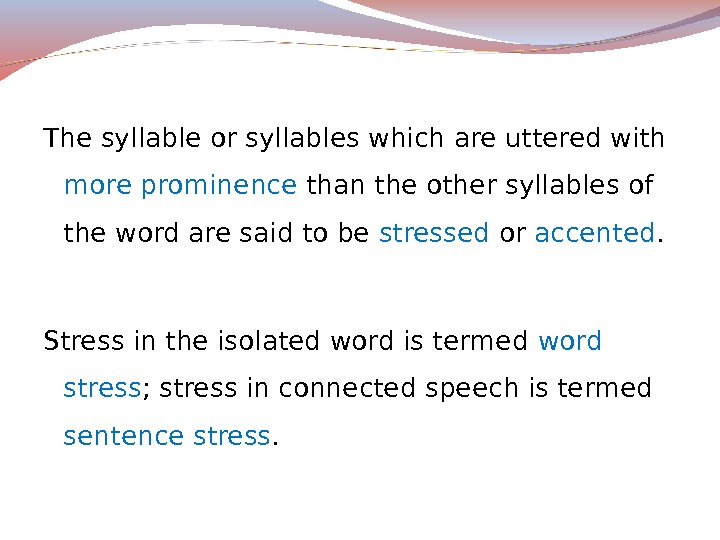

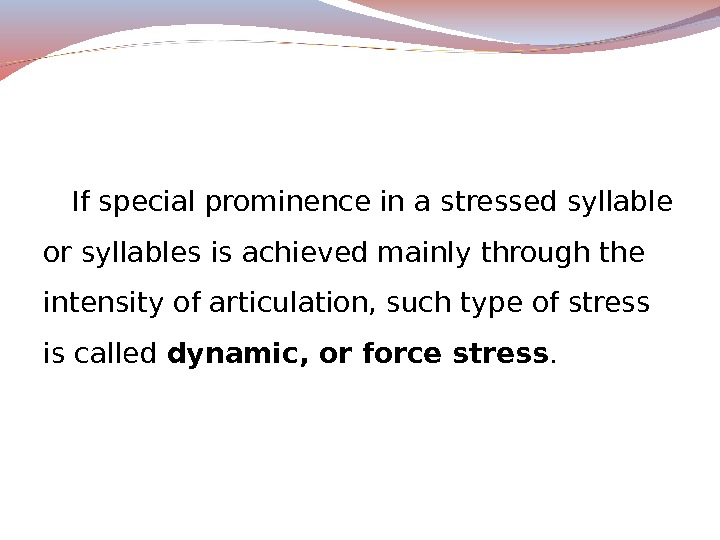
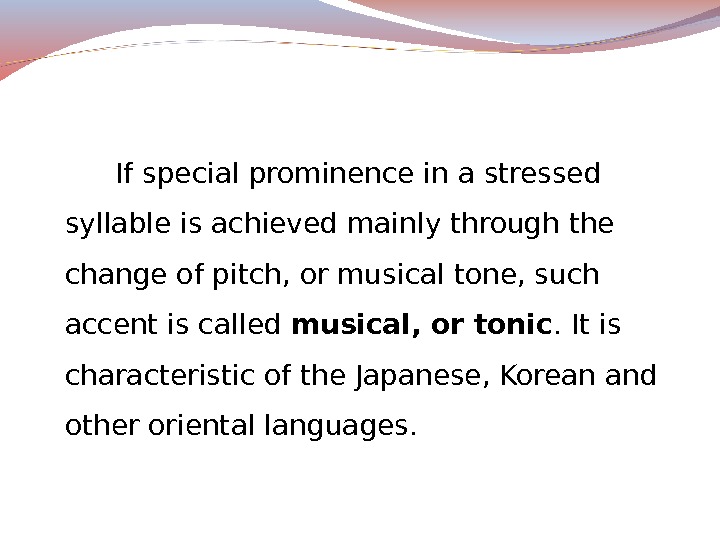


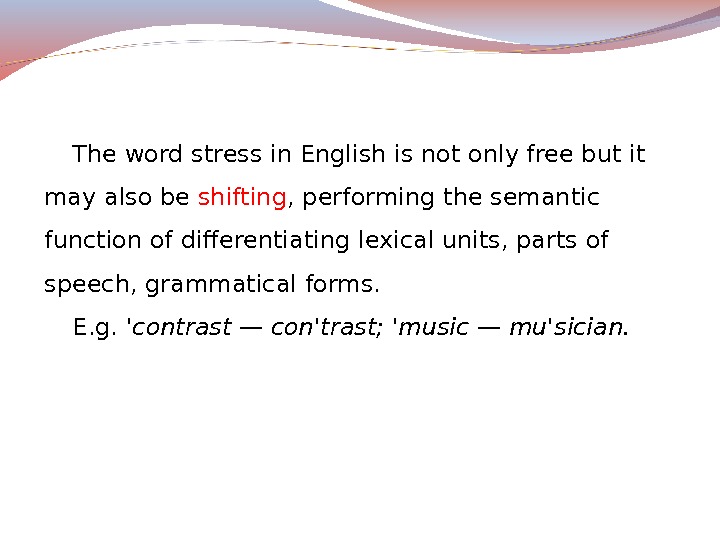
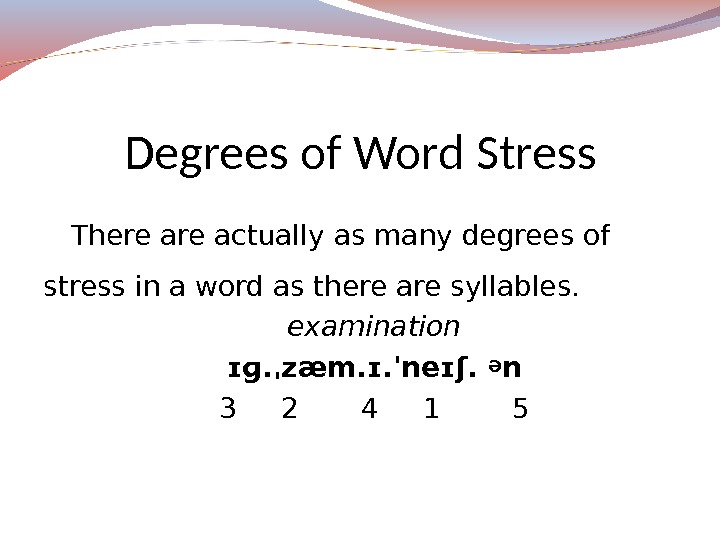
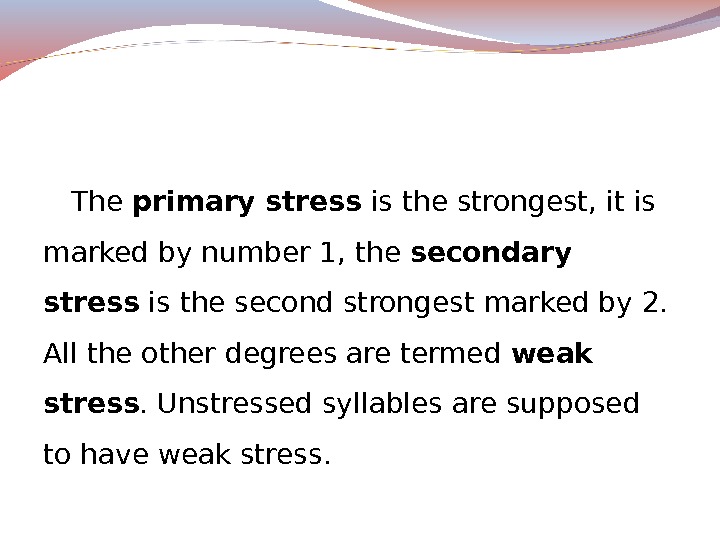

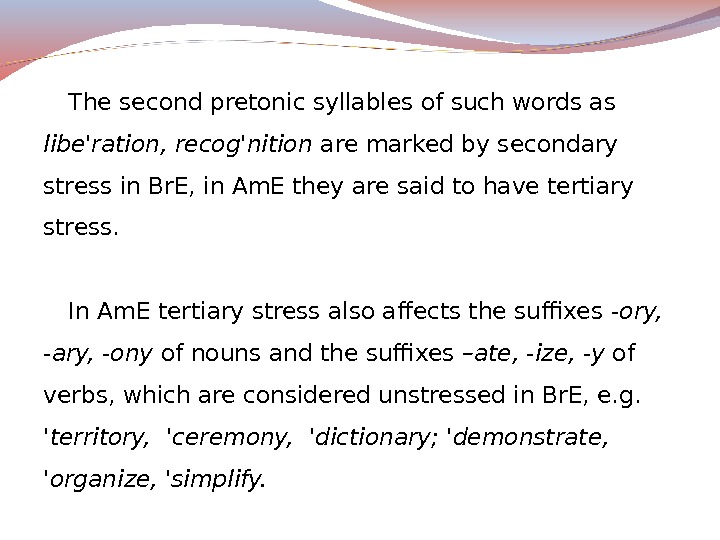
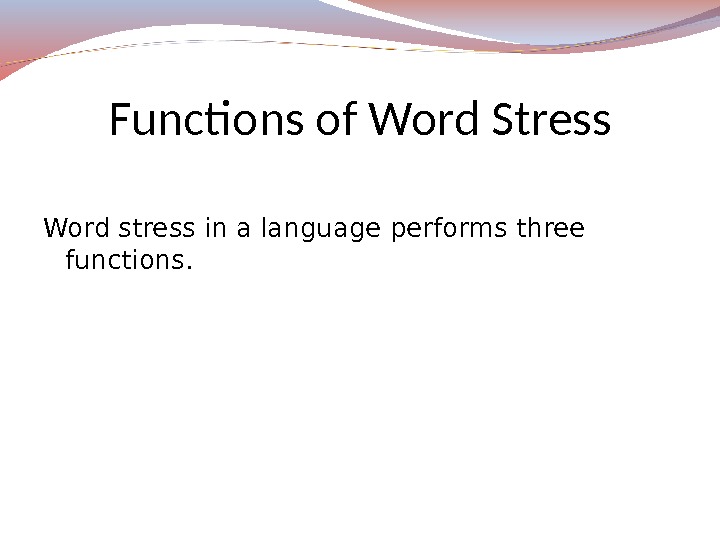


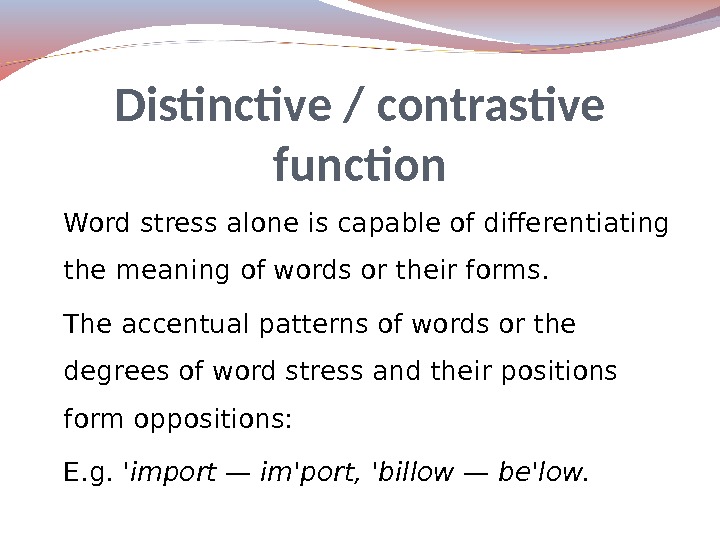
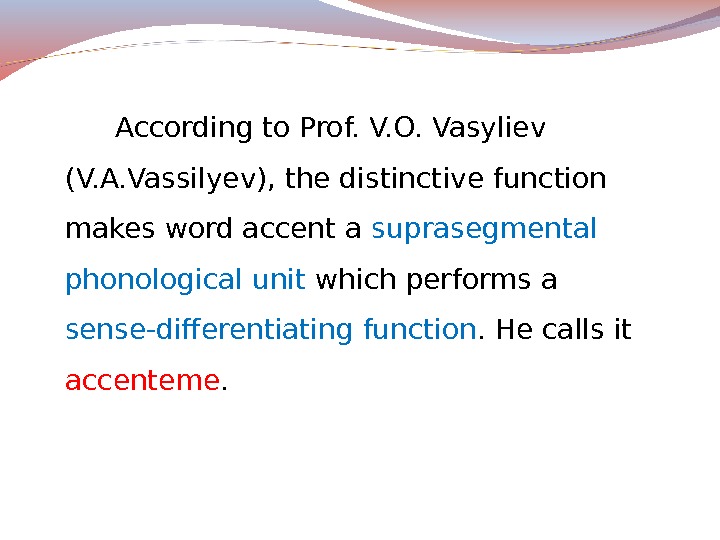
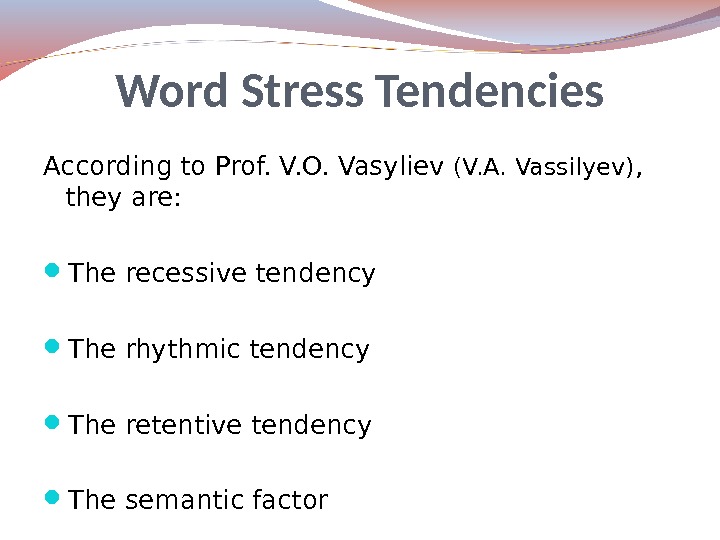


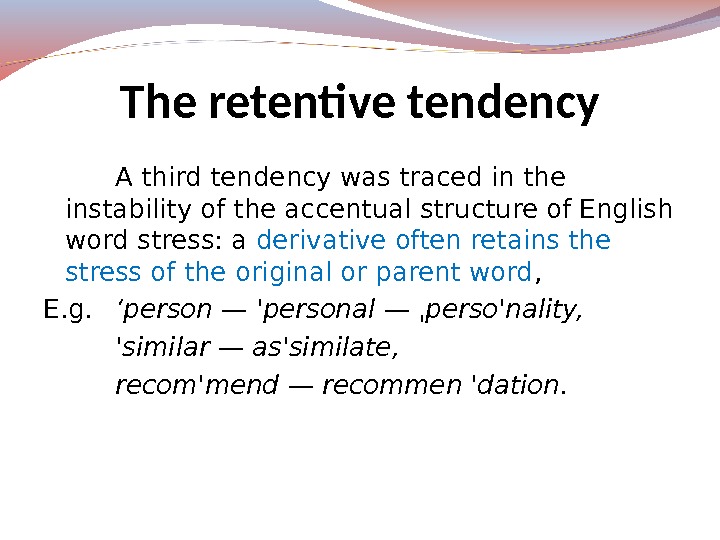
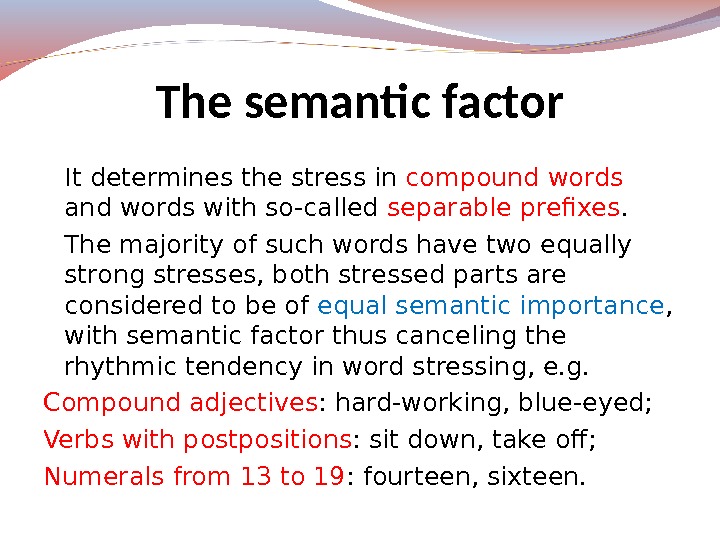

![2. [ '_ '_ ]. The accentual type is commonly realized in compound words, most 2. [ '_ '_ ]. The accentual type is commonly realized in compound words, most](https://present5.com/docs//english_phonetics_lecture_5_images/english_phonetics_lecture_5_23.jpg)
![4. [ ˌ _'___]. The accentual type marks a great number of simple words and some 4. [ ˌ _'___]. The accentual type marks a great number of simple words and some](https://present5.com/docs//english_phonetics_lecture_5_images/english_phonetics_lecture_5_24.jpg)
























![2. [ '_ '_ ]. The accentual type is commonly realized in compound words, mo... 2. [ '_ '_ ]. The accentual type is commonly realized in compound words, mo...](https://documents.infourok.ru/939f8786-d5c0-4ba5-82df-a9c1fc738db2/slide_24.jpg)
![4. [ˌ _'___]. The accentual type marks a great number of simple words and s... 4. [ˌ _'___]. The accentual type marks a great number of simple words and s...](https://documents.infourok.ru/939f8786-d5c0-4ba5-82df-a9c1fc738db2/slide_25.jpg)
